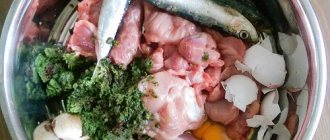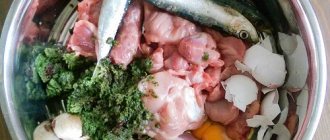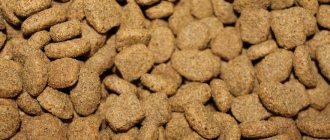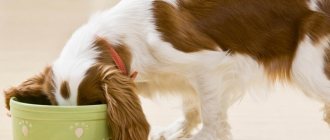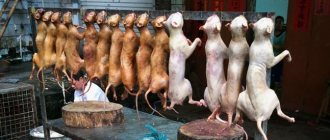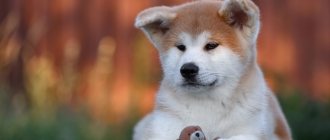How to feed a dog correctly?
The principle of good nutrition is sometimes confused with excess food in the diet. Many dogs, by their nature, are insatiable, they have no sense of proportion, and the hospitable owner rejoices as his dog absorbs more and more, and gets fat before his eyes. But it is known that a fat dog that is obese to one degree or another has a high chance of developing heart, gastrointestinal and joint diseases. Therefore, every owner needs to know how to feed a dog correctly, so as not to overfed it, but also not to keep it from hand to mouth.
Important! Under no circumstances should food from our table become a dog’s diet, no matter what breed it is. After all, spices, difficult-to-digest foods and large amounts of sugar and salt will sooner or later have a negative impact on your pet’s health.
A caring owner should know how many times a day to feed the dog in order to satisfy its hunger and satisfy the body's nutritional needs. You can learn about this and more by reading the article to the end.
How to properly feed your dog natural food?
If you have already decided what to feed your dog and have given preference to natural food, then congratulations - this is an excellent choice! All that remains is to find out what is healthy to feed your pet, and what foods are strictly prohibited. So, an adult dog of any breed (guard, hound, decorative) at home can be fed:
- raw meat and offal (beef, veal, rabbit, chicken, turkey, young lamb, kidneys, lungs, liver, trachea, udder, stomach);
- sea and ocean fish (hake, halibut, mackerel, chum salmon);
- dairy products (kefir, whey, calcined cottage cheese);
- vegetables (pumpkin, zucchini, carrots, beets);
- cereals (buckwheat, rice);
- fruits and berries.
Important! It is strictly forbidden to feed an adult dog the following foods:
- pork;
- potatoes;
- barley;
- milk;
- semolina;
- pasta;
- bread;
- legumes;
- grapes;
- raisins.
Keep in mind that when feeding a dog meat, all pieces must be cleaned of fat, and the poultry must be skinned. In addition, you need to take into account that the bulk of the meat diet (approximately 80%) should be fed raw and only a little boiled. The liver must undergo mandatory boiling, as it may contain parasite larvae.
Important! An adult dog can replace one meat feeding per week with fish, since fish in large quantities interferes with the absorption of B vitamins.
It also follows that an incorrectly composed menu for a dog can cause a chronic lack of necessary substances. Therefore, the dog should be regularly given vitamins in courses 3-4 times a year, and also flavor its food with minerals, such as bone meal.
How to properly feed your dog dry food?
More and more owners prefer to feed their pet dogs dry food. But it is not always clear what is better to feed – budget or premium food. After all, there are reviews that by saving a little, you can perfectly maintain an animal without overpaying. But veterinarians have a different opinion - cheap food, consisting of low-quality and sometimes harmful components, often causes problems in dogs. This could be allergies, indigestion, hair loss, dandruff and other troubles.
Important! In terms of volume, a portion of dry food for an animal differs significantly from a portion of natural food. You need to carefully read the information on the packaging, and also buy food that matches the specific breed.
Pay attention to what you can feed your dog so as not to harm its health, but to increase it. Premium, Superpremium class food, as well as holistic foods, can handle this perfectly:
- Happy Dog.
- Go!
- Acana.
- Nutra Gold.
- Almo Nature.
When the owner has decided what food to feed his friend, he should familiarize himself with its correct use, since the feeding process has its own nuances. Did you know that a dog fed dry food should receive twice as much water as a dog fed natural food? After all, dry pieces require a lot of liquid to swell. And another useful information - the dog becomes saturated with dry food a little later than with natural food, so it is very easy to overfeed it due to inexperience.
Top 5 best food for large breeds
Hill's Prescription Diet Canine J/D for Joint Health
Pros: dietary, will help improve your pet’s health. The food is perfect for large pets, as they most often have problems with the musculoskeletal system.
Cons: low in calories, not suitable for regular use, low in protein.
ROYAL CANIN Size Maxi Adult for large breeds from 15 months to 5 years
Good food, good composition, supports healthy skin.
Pros: the kibble is adapted to the dog’s jaw, healthy, supports the musculoskeletal and digestive systems.
Cons: relatively high price.
PRO PLAN line for large breeds
An excellent series of dry food suitable for any dog. There are specialized complexes designed for powerful or athletic large breeds, and for dogs with health problems.
Pros: it is possible to choose individually for each dog, healthy composition, contains meat, is not addictive.
Cons: high price.
Hill's Science Plan
Pros: Designed to support a strong immune system and healthy digestion. High meat content.
Cons: high price.
Acana Heritage Adult Large Breed
The food is rich in proteins and the amount of carbohydrates is reduced to maintain the health of the dog. Contains animal protein, ideal for large breeds.
Pros: ideal ratio of proteins\fat\carbohydrates, contains enough animal meat, dietary, to improve joint function.
Cons: high price.
How many times a day should you feed your dog?
While the puppy was still small, we had to feed him literally by the hour. But already at the age of one year, the diet is divided into one or two feedings. Some owners prefer to feed in the morning and evening, while others feed only before bed. Veterinarians consider both options acceptable, although the first is still better.
Important! A sick or old dog should be fed light, low-fat food, dividing the usual diet into 3-4 meals for better digestion.
If the animal is not prescribed a different regime, then the question “feed the dog before or after a walk” should not be relevant at all. And this is not a matter of habit of the dog or the owner - doctors are unanimous on this matter - you can give your pet food only after a walk, and not vice versa. The fact is that a dog’s gastrointestinal tract is designed in such a way that when overfilled with food during active movement, it can twist, forming a volvulus of the stomach and part of the intestines. Therefore, first an active walk, and then food.
If there is a need to feed the animal before walking (it cannot recover normally without replenishing its stomach with food), then the walk in this case should take place in an inactive form, only to relieve its natural needs. Only after an hour will the dog be allowed to frolic to his heart's content.
Important! In winter, when it is cold, the amount and calorie content of food for the dog kept in the enclosure should be increased.
Reviews from veterinarians
About natural nutrition:
Vladimir Mitin:
“Dogs love raw meat or fish. Cartilage and beef bones are suitable for strengthening tooth enamel.”
What foods do veterinarians recommend:
Olga Ivanchenko:
“Cheap brands will not provide the dog with adequate nutrition. I choose Canadian Pronature Holistic as a truly high-quality and complete product.”
Sergey Rudenko:
“The dog’s body reacts poorly to cheap food. Choose holistic or super premium class if it is not possible to feed your pet natural food. Among them there are both medicinal and specialized types.”
Here's what negative veterinarians say about dry food:
Ekaterina Chistova:
“A very questionable ingredient, dehydrated protein. The quality and origin of the product is unclear.”
Valentina Belova:
“Animals often suffer from low-quality food. Economy class food does not contain enough nutrients for a dog. I advise you not to skimp when choosing food.”
However, there is also an opposite point of view:
Ekaterina Nigova:
“Dehydrated protein is not suitable for breeds prone to allergic reactions to different types of food, since the exact composition is unknown. For others, there’s nothing particularly scary about this: animal proteins are good in any case as a source of protein.”
What to feed your dog to make it gain weight?
Fattening a skinny dog is not an easy task. First, you should find out what causes your dog’s weight loss. Perhaps this is underfeeding from a very early age, when the puppy was still forming. In this case, fixing something may simply be unrealistic. But if the dog was sick, then it is often quite possible to cure it and begin to gain weight competently.
Please note what to do with an underweight dog:
- contact a veterinarian who will confirm that the dog is too thin;
- on the doctor’s recommendation, deworm the animal twice, since banal parasites are often the cause of thinness in dogs;
- if no diseases are detected, such as diabetes mellitus, in which the animal loses weight, the diet can be reviewed;
- if the dog ate twice a day, also include lunch;
- food should be rich in proteins and carbohydrates, and not fats, as many people think, because their excess can aggravate some diseases; White chicken meat, bananas (if the dog likes them), and fermented milk products are best;
- If you don’t know which high-carbohydrate porridge to feed your dog, then in the case where the dog does not have milk intolerance, ordinary semolina porridge helps very well.
Now let's discuss what to feed a pregnant, lactating or postpartum dog. Indeed, during all these periods, the bitch requires increased attention to herself, as well as to her diet:
- In the first month of pregnancy, the dog should be given a little more food than usual or another feeding should be added. About 2 weeks before giving birth, you should cut down on your diet, removing as many carbohydrates and fats as possible. Instead, the bitch should receive protein, a multivitamin complex and fish oil.
- After giving birth and during lactation, the bitch is fed intensively, with a high calorie content, until the puppies suckle from their mother. Beef tripe is very useful for the dog at this time - the stomach contains the enzymes necessary for a nursing mother for rapid recovery.
Special food for large breeds
Hypoallergenic feeds are high-quality diets for animals that are allergic to certain synthetic feed components. All holistic foods can be called hypoallergenic.
ACANA Grass-Fed Lamb for all breeds, lamb, apple
BRIT VDD Hypoallergenic grain-free hypoallergenic diet
ROYAL CANIN Vet Diet Hypoallergenic DR21 for food intolerance, poultry
There are also special foods for sterilized large dogs. During the postoperative period, it is important to monitor your pet’s diet, as the metabolism undergoes changes.
Acana Light&Fit
Choose dietary food, or even better, consult the doctor who performed the sterilization.
What should you not feed your dog?
Knowing what to feed your dog, you can give it several years of life. But improper and irregular nutrition, on the contrary, can undermine the health of a four-legged friend and shorten his already short life. The dog is not fed “human” food. That is, such products harm her:
- potato;
- legumes;
- flour products;
- citrus;
- sweets;
- spices;
- smoked meats and pickles.
Important! Feeding a large or small dog natural food does not mean feeding it bones! Whole, unchopped, raw sugar bones are given to a puppy during the period of permanent teething, and also as a reward for an adult dog. But they are not a substitute for meat, because they often lead to intestinal blockage and even rupture.
Some owners manage to feed their dogs cat food. This absolutely cannot be done, because dogs and cats have completely different needs and such food, of course, will fill you up, but will not be beneficial.
Diet selection
When choosing a puppy’s diet, you should carefully study the composition, make sure that the food is well balanced and contains the optimal vitamin and mineral complex for your pet.
For large breeds
Large breeds require food with a higher percentage of meat. The pet’s development and muscle mass gain will depend on the quantity and quality of protein. In addition to meat, you need: rice, potatoes, no more than 10–15% fish, high-quality and balanced vitamin complexes.
During the growth period, it is useful to give the puppy calcium gluconate, seaweed, and fish oil. These requirements are met by products from Now, Farmina N and D maxi breed, Brit care maxi.
For medium breeds
Up to six months, it is allowed to use food for small breeds of puppies, and after six months, food for large dogs is suitable. It is important to choose a balanced composition. Dry food for medium breed puppies is easy to find by the presence of the prefix medium on the package. Veterinarians and breeders note the quality of products from Brit, Hills, and Bosch.
What else do you need to know about feeding dogs?
Every year, every adult dog should come to the doctor for a preventive vaccination. As a rule, the animal tolerates vaccination without consequences, since the body has already developed a strong immunity.
But there is also a nuance here - if you decide to switch your dog from one type of feeding to another (from dry to natural or vice versa), then in no case should this be done before vaccination. You should think about this a couple of weeks before going to the vet or wait the same amount after the injection.
All cases of feeding a dog with natural or dry food are suitable for a healthy animal. But what to do if your pet suddenly gets sick or his illness turns out to be incurable? Let's find out what to do.
What to feed your dog after poisoning?
Does your dog pick up everything on a walk? Then she has every chance of being poisoned by spoiled food. When poisoned, the dog loses a lot of fluid, and toxins attack the body from the inside. Immediately after poisoning, it is advisable to wash the animal and put it on a starvation diet for a couple of days. Afterwards, in order to alleviate your pet’s condition, you should adhere to the following principles:
- transfer the dog to small meals (4-5 times a day);
- give food slightly warmed up;
- exclude fatty foods;
- give light broths;
- porridge - only rice and buckwheat;
- meat - chicken or horse meat.
What to feed a dog with diarrhea?
Indigestion is not only an unpleasant, but sometimes a dangerous problem. Eating should be suspended for at least a day. Instead of food, the bowl should always contain unlimited amounts of clean water. If the dog is upset, do not give it fatty or raw foods. As soon as things get better, you should include light foods in your diet, exclusively in boiled form.
Important! In case of poisoning, diarrhea or vomiting, the dog's food must be added with salt to restore mineral metabolism.
What to feed a dog with diabetes?
Like people, dogs with diabetes begin to have problems eating (lack of appetite) and the dog loses weight very quickly. To minimize losses, you should walk your pet more often, working up an appetite, and try to give him more high-calorie food. If the dog was on dry food, the veterinarian will recommend a special therapeutic diet. Natural products should include:
- hard cheese;
- cereal soups with meat broth;
- meat of different types, as well as fish, but in boiled form.
Be careful! Vegetables, fruits and refined rice are not allowed for dogs with diabetes.
Wet food
Wet food – canned food for dogs. Fast, nutritious, convenient. Sometimes it’s healthier than the same dry food. Available in the form of cans or small plastic containers.
| pros | Minuses |
|
|
The volume of a single portion of wet food is dictated by the volume of the can or container. There are specially selected foods for different breeds of dogs.
Calculate the daily amount of calories according to your dog's weight (53-60 kcal per kilo of weight for large breeds). Two meals a day is enough. Liquid food contains a large amount of fat and is very high in calories.
Is it possible
Raw
It is not only possible, but also necessary - feeding raw meat is the best thing you can imagine. Moreover, it is precisely this that should form the basis of the “meat” part of the diet. But at the same time, the meat must be of high quality and fresh. If there are concerns, then meat products can be doused with boiling water.
Pork
Why can't you feed your animal pork? In fact, contrary to the stereotype, dogs can eat pork. Of course, it is wiser to refuse meat from freshly killed wild boar, but a lean piece of high-quality meat will only benefit the dog:
- Do not give your dog raw pork - it may be infected with parasites. The same goes for offal.
- It’s better to give boiled lean pork: boiled pork heart, lung, etc.
- Strong freezing of meat does not guarantee its safety - and this applies not only to pork. Try to choose meat that has undergone a sanitary inspection to ensure the absence of parasites.
Boiled
Which is better: raw or cooked meat? Raw meat is digestible better than boiled meat, it is healthier for dogs and, of course, it should be preferred over boiled meat.
Is it possible only with meat?
You can't feed dogs meat alone. Not to mention the fact that with such feeding, the pet will not receive the vitamins, minerals and amino acids it needs, contained in other products; in addition, if fed only meat, it may develop protein poisoning.
To soak or not?
If we are talking about feeding an adult animal, then we should proceed from the preferences that have emerged. Dogs love to crunch and react poorly to the resulting porridge after adding liquid. But if the animal previously ate porridge, then the transition to pellets will be easier if you soak them. Moreover, additional liquid is a good way to provide additional fermented milk products, which are also good for the stomach.
Add liquid if:
- The pet is up to 4 months old . They most often add boiled milk to the granules in a ratio of 1/2 or 1/3 for better digestion or absorption of products.
- In old age or if you have problems with your teeth, you can also add water.
- With excessive greed. If your pet quickly eats the entire portion and does not feel full, which is why he constantly overeats and gains weight.
- If you have diseases of the gastrointestinal tract or mouth.
When adding additional ingredients, be it water or kefir, the weight of the portion does not change.
Calorie content of products of various brands
Royal Canin
Manufacturer, one of the leaders in the animal feed market. This brand produces products of the highest quality, made exclusively from natural raw materials: meat, fish, poultry, vegetables, cereals.
For the convenience of calculating the average daily intake of food for a given brand, you can use the following table:
The small daily intake of dry food produced under this brand is due to its high nutritional and energy value. The optimal calorie content of such products provides the dog with the necessary energy and a full range of vitamins and minerals.
Chappi
This brand produces dry food of relatively good quality. The raw materials for the manufacture of products of this type are usually cereals, meat, offal, fats of animal and vegetable origin. As an additional beneficial ingredient, the manufacturer uses brewer's yeast, which has a beneficial effect on the condition of the pet's coat and skin.
We invite you to familiarize yourself with: Japanese Chin photo, description of the breed, character, reviews, care and video
To calculate the average daily intake of food for a given brand, it is recommended to use the following table:
ProPlan
Another well-known manufacturer that produces products that are intended for a wide variety of categories of dogs. The range of products of this brand includes food for pregnant and lactating bitches, puppies, sterilized animals, as well as for adult dogs with overweight, sensitive digestion, powerful, athletic and asthenic physique.
The main raw materials for this type of product are dried meat and fish, cereals, vegetables, powdered eggs, and fish oil. Recommended daily intakes of the product are shown in the table below:
Experienced dog breeders recommend using a tablespoon (for dwarf dogs and puppies) or electronic scales (for large dogs, pregnant and lactating animals) to conveniently determine the volume of each serving. Using these methods, you can measure the required amount of product if the package does not have a measuring cup.
It should be noted that elite expensive feed, due to its high nutritional value, is consumed very economically. A large package can last for several weeks (depending on the pet's age, breed, health and weight). For this reason, it is important to pay special attention to the correct content of the product. It should be stored in a dry place with good ventilation.
Standards for natural nutrition
With natural nutrition, take 40 grams of dry food, the same amount of wet food and fiber per 1 kg of body weight. For pregnant women, service dogs and stud dogs, the amount of natural food can be increased.
With average physical activity, a dog weighing up to 40 kg requires per day in grams:
- meat – 600;
- cereals – 500;
- vegetables – 200-300.
During heavy physical activity, a relative in the same weight category needs (in grams):
- fresh meat – 1000;
- cereals – up to 700;
- vegetables – 300.
For increased physical activity, for a dog weighing more than 40 kg, the following should be used per day (in grams):
- meat – 500;
- cereals – 700;
- vegetables – 400.
It is also recommended to add 50 g of meat and fish bone meal to the diet, from fermented milk products - kefir and fermented baked milk, in a volume of 100-200 ml, cottage cheese - from 200 to 500 g.


